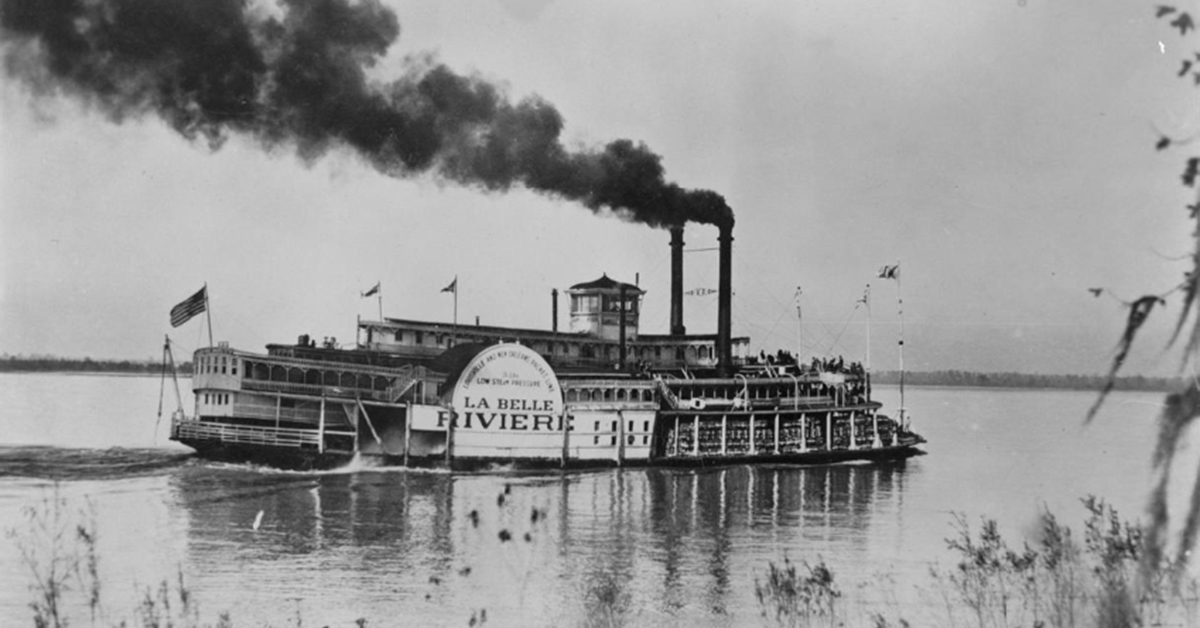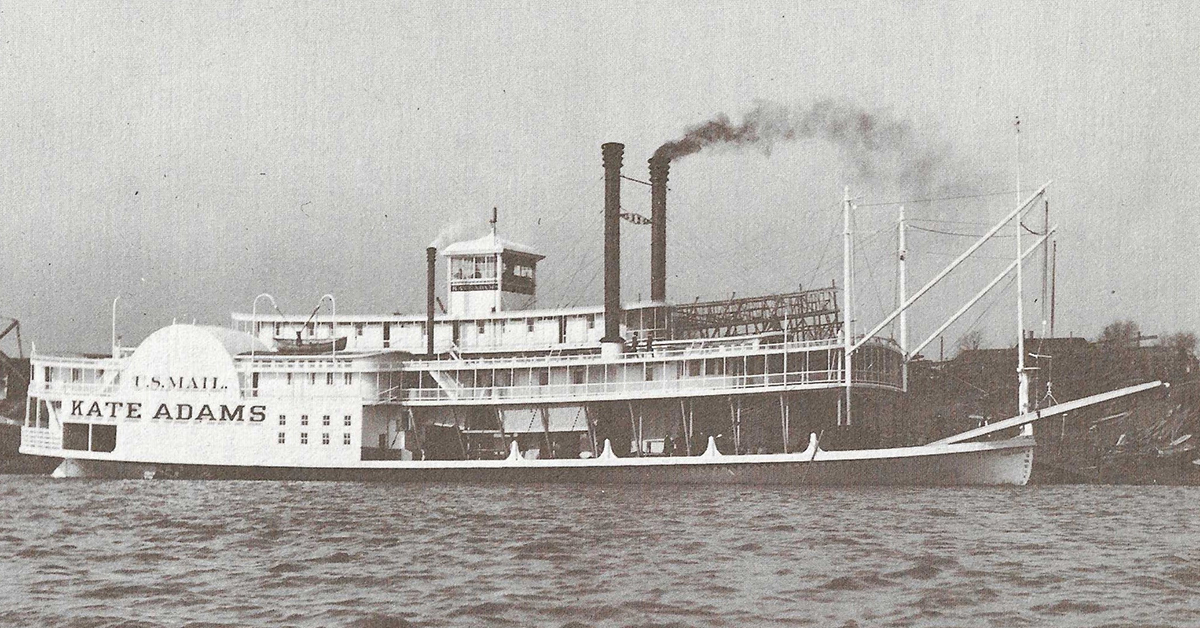In the June 9, 2025, installment of “This Week” in The Waterways Journal, the following was included in the section from 100 years ago: “The mv. Kate Adams departed Paducah, Ky., for Pittsburgh to enter the packet trade to Cincinnati.” This was actually the steamer Kate Adams, and there was a lot contained in that small statement.
There were three packet steamers named Kate Adams. All worked for the Memphis & Arkansas City Packet Company, and all were large sidewheelers. The first was a 250-foot by 37-foot wooden-hulled vessel that was built at Sewickley, Pa., and Pittsburgh in 1882. That vessel burned below Memphis, Tenn., on December 23, 1888. The second, also with a wooden hull of 250 by 36 feet, was built by the Howards at Jeffersonville, Ind., in 1889. Way’s Packet Directory shows a build date of 1888, but the Howard records in “From Paddle Wheels to Propellers,” a history by Charles Fishbaugh, shows it was built in 1889. That vessel was sold to the Chalmette Packet Company and renamed Dewey in 1898.
The third Kate Adams was also a product of the Howard yard but had a steel hull that measured 240 by 40 feet. James Rees and Sons of Pittsburgh (who also held an interest in the owning company) held the contract to build the boat and subcontracted the work to Howard. Capt. James Rees and marine architect Thomas Dunbar superintended the construction of the wooden cabin and installation of the Rees-built engines that were 24’s with 8-foot 8-inch stroke. Steam was supplied by four boilers that were 48 inches in diameter and 28 feet long.
The Marine Review for January 1899 carried a glowing review of the new Kate Adams, saying it was “probably the most notable vessel built during the past year in the shipyards of the Ohio and Mississippi Rivers.” The piece went on to say that the Kate Adams would mark a new era of shipbuilding on the rivers as it was “the first steel hull sidewheel packet boat built for passenger and freight service on the rivers.” The new steamer was built “with particular regard to requirements for carrying the United States mail” and cost approximately $90,000.
Capt. Mark R. Cheek was first listed as master, and by 1900 he was superintendent of the packet line. Capt. Grant Marsh of Missouri River fame was master. Capt. Robert R. Agnew was later master, followed by Capt. W.J. Hodge. By 1919, the route for the Kate Adams was extended to Rosedale, Miss., and the name of the owning firm became the Memphis & Rosedale Packet Company. In 1922, the U.S. Mail contract was lost to the Lee Line of Memphis, and the route of the Kate Adams was extended to Greenville, Miss. In 1923, the name of the owner changed to Delta Line. In the following year, Delta Line merged with the Lee Line to become Valley Line Steamers. In August of that year, the lucrative mail contract was captured by the Missouri-Pacific Railroad. Freight and passenger volumes diminished over time due to railroad competition and the construction of reliable highways.
In the early spring of 1925, the Kate Adams was taken to Paducah. Ky., where extensive alterations were made, including the extension of the boiler deck to cover the cotton guards, the addition of bull rails and stationaries around the main deck and hinged smokestacks for transiting under low bridges.
This now brings us to the recent “This Week” entry about the Kate Adams departing Paducah for Pittsburgh. It was big news at the time that a palatial Mississippi River cotton packet would be entering the Pittsburgh–Cincinnati trade. At the time, a few much smaller steam sternwheeler packets handled that trade, and they were basically struggling to make ends meet due to the same conditions that forced the big boat off the Mississippi. Capt. Frederick Way Jr. was the owner and operator of the Betsy Ann, which was in that trade. Way related in his book “The Log of the Betsy Ann” how devastating the news of the Kate Adams entering the trade was to the other packet operators.
Way records that even those that hated the fact that the big Kate Adams would be competing with them for business were in awe at her first majestic appearance in the Pittsburgh harbor. Other boats were blowing their whistles in salute, and people were shouting that the “Lovin’ Kate” (the nickname the massive vessel had acquired during the years on the Mississippi) had come to town. The large sidewheeler finished out the 1925 season in the trade to Cincinnati and returned after the winter to start the 1926 season.

In the fall of 1926, it was taken back to Memphis for extensive alterations for a special task. The Kate Adams was chartered to star in the film “Uncle Tom’s Cabin.” For this production, the boat was decked out to appear as an antebellum river packet and temporarily renamed La Belle Riviere. Way’s states that Capt. Gus Phillips was in charge as the boat went to the Ouachita and Black rivers in Louisiana for filming. Afterward, the boat returned to Memphis and, at much cost, was restored to its former state to resume the Pittsburgh–Cincinnati packet trade.
On January 8, 1927, the Kate Adams caught fire and burned at Memphis, leaving only the steel hull. The hull was later used as a barge to tow cotton. It sank at Memphis in 1931 with some 5,000 cotton bales on board. The hull was later raised and abandoned at the foot of President’s Island.
The roof bell from the last Kate Adams wound up at the Mariner’s Museum of Newport News, Va. The deep “bull-frog” whistle was later said to be on the steam sternwheel towboat Leona, but Capt. Way was somewhat skeptical about it. Artist Michael Blaser some years ago painted a beautiful work titled “Nocturne,” which depicted a nighttime scene of the Kate Adams on the Ohio River meeting the towboat J.T. Hatfield (the first).
A print of the painting hangs above this writer’s desk.
Featured image caption: The then-new Kate Adams at Howards in 1898. (From the Howard Steamboat Museum collection)




